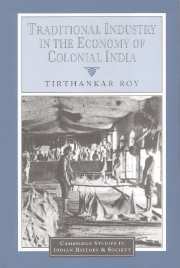3 - Handloom weaving
Published online by Cambridge University Press: 05 July 2009
Summary
Any general account of the history of the Indian artisan in the nineteenth and twentieth centuries must begin with textile production. In the 1911–31 censuses, a quarter of the workers in industry were employed in textiles, and in mainly artisanal textiles. The share of textiles in employment was probably higher about 100 years previously, but it declined only to stabilize at a percentage that still made it the largest industry by far. Textiles has unique historiographic significance. Its importance reflected the fact that cloth, unlike the other products dealt with in this book, was a mass-consumed good. Its history is bound up with the histories of inland trade and patterns of consumption. Textile history is a particularly good example with which these changes can be understood. Further, cotton textiles is the most important example of a craft threatened by steam-powered technology, or of premodern industry threatened by the Industrial Revolution, or even of Indian livelihood threatened by industrializing Britain. The threat came from Lancashire until the prewar decade, and from Bombay in the interwar period. Despite the unequal nature of the contest, handloom weaving in India did not succumb. The market-share of handloom cotton cloth was roughly stable between the 1890s and the 1930s, and no overall decline in loomage can be established from the periodic loom censuses.
- Type
- Chapter
- Information
- Traditional Industry in the Economy of Colonial India , pp. 61 - 98Publisher: Cambridge University PressPrint publication year: 1999
- 1
- Cited by

